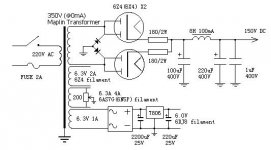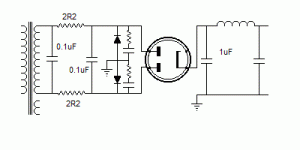... tweak as tweak does...
Hi Frank,
Thanks for the pictures. They illustrate nicely what we have been talking about.
I would suggest that in the first case the snubbers had not been optimised for the given components around the diodes - or the psu load was different from the load at optimisation as snubbers should do better than that... However they do only minimise the nasty's for a 1N4007 and get it about equal to a typical valve rectifier (in my experience...)
The Schottky diodes look nice - must try them one day. I saw on the asylum a suggestion to use a ss BR with a tube rectifier in series to get the soft start and some isolation from the hash...not sure I agree with that as the hash still gets into the transformer and from there to the negative rail...and it still radiates everywhere... Ithink you need to kill the oscillation at source...
cheers
james
Hi Frank,
Thanks for the pictures. They illustrate nicely what we have been talking about.
I would suggest that in the first case the snubbers had not been optimised for the given components around the diodes - or the psu load was different from the load at optimisation as snubbers should do better than that... However they do only minimise the nasty's for a 1N4007 and get it about equal to a typical valve rectifier (in my experience...)
The Schottky diodes look nice - must try them one day. I saw on the asylum a suggestion to use a ss BR with a tube rectifier in series to get the soft start and some isolation from the hash...not sure I agree with that as the hash still gets into the transformer and from there to the negative rail...and it still radiates everywhere... Ithink you need to kill the oscillation at source...
cheers
james
NOTHING'S EVER PERFECT.
Hi,
James,
The snubbers could have been better optimised, I agree, still the purpose was to show the difference between the two types of diodes.
I've also done some experimenting by adding a small value, no more than a few Rs behind the rectifiers and this smooth them too.
Have listened to it yet but I expect it may kill dynamic range a bit...
The hybrid rectifier Thomas mentioned looks like this I suppose?
Hi,
James,
The snubbers could have been better optimised, I agree, still the purpose was to show the difference between the two types of diodes.
I've also done some experimenting by adding a small value, no more than a few Rs behind the rectifiers and this smooth them too.
Have listened to it yet but I expect it may kill dynamic range a bit...

The hybrid rectifier Thomas mentioned looks like this I suppose?
Attachments
hi frank,
U right, this one is the really combine circuit that some people in hong kong using.
Do U think that this will better than only use one rectifier tube or another method that parallel two rectifier tubes to rectify.
thanks
Thomas
U right, this one is the really combine circuit that some people in hong kong using.
Do U think that this will better than only use one rectifier tube or another method that parallel two rectifier tubes to rectify.
thanks
Thomas
GOOD, BETTER, BEST.
Hi,
Excuse my sarcasm in the header.
While I can judge which of which is better, the purpose... or let me rephrase that, the idea behind it is to combine the best of both worlds.
In reality it basically achieves two things:
It rectifies the B+ fed to it and it provides an elegant soft start to the tubes.
I'd advise to put some snubbers across the silicon diodes nonetheless although the tube rectifier seems to be very kind to absorbing their peaks along the way.
Intuitively I'd say that this circuit promises a good sound along with a prolonged life to the tubes feeding it.
So, yes I quite like it...surprised to learn it leaked all the way to Asia though...
Guess it confirms my experience with the Asian...😎
Cheers,
P.S. I hope you understand my English, if not I'll try to simplify it.
Hi,
Excuse my sarcasm in the header.

While I can judge which of which is better, the purpose... or let me rephrase that, the idea behind it is to combine the best of both worlds.
In reality it basically achieves two things:
It rectifies the B+ fed to it and it provides an elegant soft start to the tubes.
I'd advise to put some snubbers across the silicon diodes nonetheless although the tube rectifier seems to be very kind to absorbing their peaks along the way.
Intuitively I'd say that this circuit promises a good sound along with a prolonged life to the tubes feeding it.
So, yes I quite like it...surprised to learn it leaked all the way to Asia though...
Guess it confirms my experience with the Asian...😎
Cheers,
P.S. I hope you understand my English, if not I'll try to simplify it.
mix and match
If what I read here is true and if solid state rectification is bad news, the mix and match scheme is the worst of both worlds.
The solid state diodes give us noise and the vacuum rectifier gives us poor regulation.
The only positive thing, that I see, is the gentle ramping of the HT.
Is it that improtant to see a glowing filament?
If what I read here is true and if solid state rectification is bad news, the mix and match scheme is the worst of both worlds.
The solid state diodes give us noise and the vacuum rectifier gives us poor regulation.
The only positive thing, that I see, is the gentle ramping of the HT.
Is it that improtant to see a glowing filament?
If what I read here is true and if solid state rectification is bad news, the mix and match scheme is the worst of both worlds.
I agree. Unless it sounds amazing for inexplicabe reasons (won't be a first 🙂 ) i really don't see any real point.
... Good reasons aren't always obvious...
There is a good reason that I'm using a Bridge rectifer circuit. My mains transformers do not have a center tap...so I need a Bridge to get a nice high B+. Building BR with DHR (directly heated rectifiers) means lots of different floating filaments windings...don't have then either - so a BR is what I need and so I compare a ss BR with a hybrid BR....
Does it sound as good as a DHR full wave ? Well in some circumstances it is sounding better - some worse...
There are no 100% better solutions - I have pp sounding better than SE and vice versa. It all depends on the particular implementation...
ciao
Jmaes
There is a good reason that I'm using a Bridge rectifer circuit. My mains transformers do not have a center tap...so I need a Bridge to get a nice high B+. Building BR with DHR (directly heated rectifiers) means lots of different floating filaments windings...don't have then either - so a BR is what I need and so I compare a ss BR with a hybrid BR....
Does it sound as good as a DHR full wave ? Well in some circumstances it is sounding better - some worse...
There are no 100% better solutions - I have pp sounding better than SE and vice versa. It all depends on the particular implementation...
ciao
Jmaes
They're here, finally
http://www.builditmall.com/tubebuil...?page=scstore/results&Category=SEMICONDUCTORS
High voltage Schottky's for the masses...
$4US ea for the 600V 4A's ...quite affordable for use in a preamp
$12.50US ea for 1200V 5A ...not quite so affordable.
Pete
http://www.builditmall.com/tubebuil...?page=scstore/results&Category=SEMICONDUCTORS
High voltage Schottky's for the masses...
$4US ea for the 600V 4A's ...quite affordable for use in a preamp
$12.50US ea for 1200V 5A ...not quite so affordable.
Pete
A discussion of the hybrid Greatz bridge can be found here, with some interestin points made by Gary Pimms.
http://www.audioasylum.com/forums/tubediy/messages/27875.html
http://www.audioasylum.com/forums/tubediy/messages/27875.html
That's what I thought too...
Cheers,
So it's closer to being the best of both worlds, rather than the worst of 😉Brett said:A discussion of the hybrid Greatz bridge can be found here, with some interestin points made by Gary Pimms.
http://www.audioasylum.com/forums/tubediy/messages/27875.html
Cheers,
- Status
- Not open for further replies.
- Home
- Amplifiers
- Tubes / Valves
- Tube Regulator

